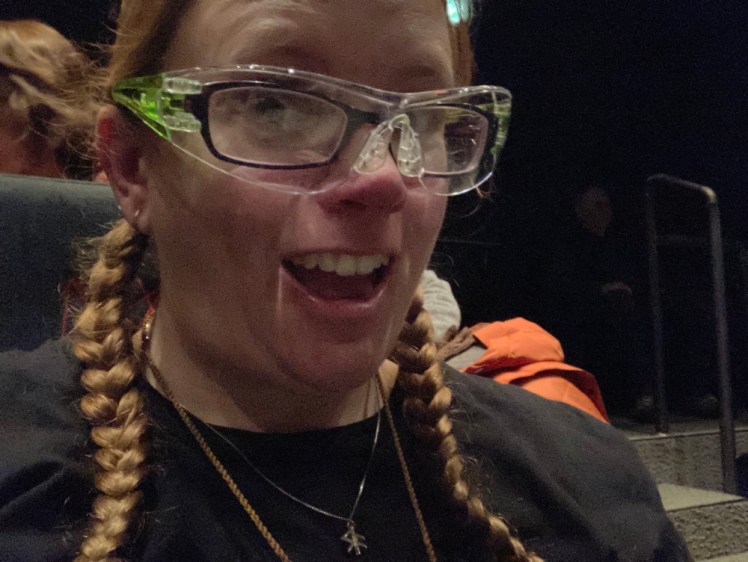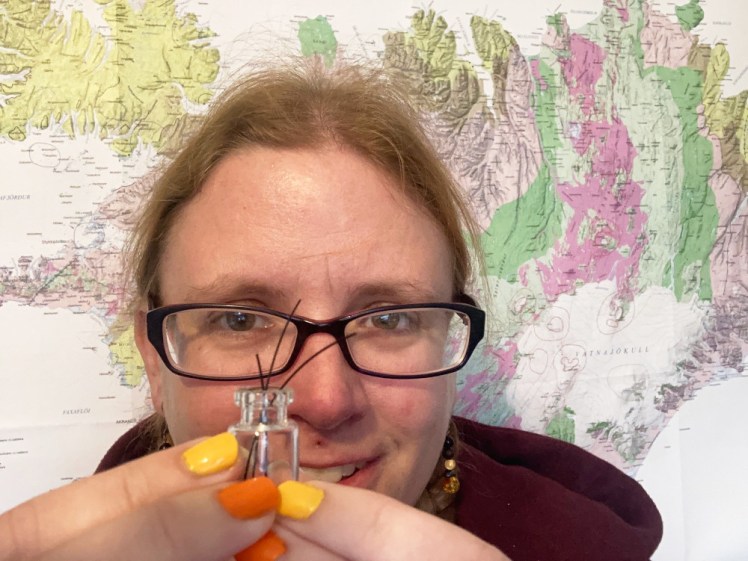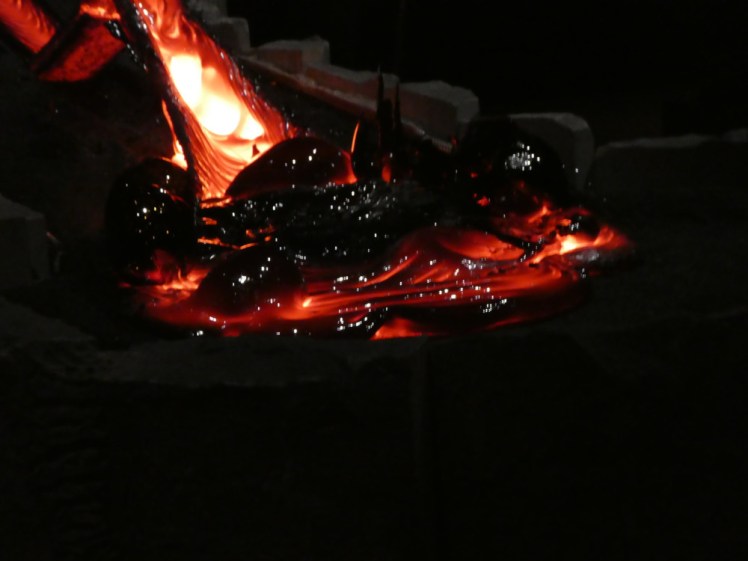This is possibly the thing I was most excited about when I went to Iceland: I went to Lava Show Reykjavik. They make lava in a theatre!

Lava Show originally opened in Vík, a small town on the south coast where tourists tend to stop for fuel on their drive along the south coast. I had it on my list to visit this summer but they recently opened a second location right here in Reykjavik and that meant it was the very first thing I planned once I had my February dates booked in. Disclosure: for all the raving you’re about to get, I couldn’t book online – there’s some kind of new EEA thing that means sometimes cards just can’t process and I’ve fallen victim to it in Iceland so many times. I tried three cards, I entered the approval code, I did everything but it just returned “can’t process card” over and over again. I’ve had this with the Sky Lagoon, with both RE and Grayline when I tried to book my airport buses, and with Hvammsvik. In the case of Lava Show, I emailed them and they booked it on my behalf and said “you can just pay when you arrive” so that was really easy. Not as easy as just booking it but eminently doable.
It’s on the other side of the old harbour in the Grandi district. This is a sort of industrial but also up-and-coming area where you can find cute cafes and be cool for knowing about it but it’s also where you’ll find an entire street of warehouses and mid-sized supermarkets. But it also has some great wet-weather tourist attractions. Over the coming weeks and months, I’m going to cover five of them, which I did all in one day. Bus 14 goes from downtown Reykjavik to Grandi but I walked. I was staying in downtown Reykjavik, next to bus stop 3, next to Hard Rock Cafe, above Messin fish restaurant, and that was about 2km each way and took about half an hour.
My booking was for the 2pm show. It was snowing like the world was trying to end, I’d been in and out of various exhibits and supermarkets and eventually decided I’d just go to the Lava Show, where they had a cafe of some kind and I could surely shelter there for forty minutes. Yes, no problem. Plenty of people sitting around waiting, some with drinks from the bar. I asked tentatively if I could eat my own food there, since I’d brought lunch but couldn’t eat it outside in the snow, and that was fine. When I’d eaten, I prowled the shop, which is really just a big cube shelf. Lots of postcards and pictures, some t-shirts (I’d have 100% got the LavaGirl one if they had it in anything other than one child size), some bottled Pele’s Hair (more on that later), whisky stones – the usual, but a bit more volcano-themed.

At about ten to two, we were invited to go in. There’s a big screen on the wall and below that, a slide and sand basin, all made of steel. There are three rows of seats on three sides and more seats, behind plastic screens, on a balcony above it all. You chose your own seat and there’s a pair of safety glasses perched on it. Our Lava Master, Madison, recommended we sit anywhere from about halfway along the side and that seats slightly raised and at the back are actually better seats than you think. Then you watch a video about the majesty and terror of volcanoes and then the real show gets started.

The lava is actually sand and gravel gathered from the 1918 Katla eruption, which was witnessed by the founders’ grandfather. It’s why the original show was in Vík too; that’s where the family is from, that’s where the lava is from, that’s where the inspiration is from. Unfortunately for them, Reykjavik is where most of the tourists are, though, so it had to come here. Behind the scenes is a furnace and Dominic, dressed in a big silver suit with a gold reflective visor, is shovelling in sand and the cool lava from the last show to melt it back into fresh lava. Madison explained that this stuff has been degassed – when the rock melts to make lava, toxic gases escape and that’s a major hazard in an eruption. But in this particular case, this stuff has been melted over and over again and the gases are long gone, which is why it’s safe to hold this show in a relatively unventilated theatre.

Dominic opens the hatch at the back and pours a great big dollop of lava onto the slide. This is pahoehoe (pa-hoy-hoy) lava which is basaltic and fairly effusive, which means it’s runny and fast-moving and as it cools, it wrinkles like the skin on custard. Rhyolitic lava is called ‘A’ā (ah-ah) and it’s rough and spiky and noisy and moves very slowly. If we’d been using rhyolitic ‘A’ā lava, the show would have had to last at least two hours just to get it down the slide. And as Madison responded very seriously to a question from a small child, volcanoes in Minecraft erupt rhyolitic lava, not basaltic – that’s where the obsidian comes from.

Anyway. A silence hangs over the room as this molten lava slides down the slide and onto a patch of ice half-buried at the bottom. It glows yellow-white and as it hits the ice, it begins to sizzle, a miniature version of what happened at Eyjafjallajökull, when the eruption happened under a couple of hundred metres of glacier, but without the ash cloud. Madison added an inch-thick disc of ice to the fresh lava and it began to blow up into bubbles, bubbles which went from yellow to red to black within seconds. Within another minute, the bubbles had cooled enough to solidify and so our Lava Master took her steel pole and smashed them. Yes, smashed. They tinkled like glass. That’s because technically they are glass. Glass is really just melted sand, which is what we had right here. That’s how the subject of Minecraft came up – this is volcanic glass but it’s not obsidian because this is the wrong kind of lava for that.

On the surface, lava sets very quickly, hence the smashing of the solid bubbles. The whole slither of lava went from glowing white-yellow to black within about ten minutes, although the heat kept coming off it for a long time. How far was I sitting from the end of the lava flow? Maybe two metres? But lava is also a very good insulator, which means it stays hot underneath. I’d already experienced that – exhibit a, the boiling water still pouring out of the lava field at Landmannalaugar 5000 years later and exhibit b, people making toast on top of Eldfell which erupted in 1973. Here you could see it quite clearly. Under the protective bubbles, which were solid and black and cooled, the lava was still red hot. Madison dug her pole into the lava flow on the slide and lifted it up, showing that it was red underneath but also that it was hot enough to be able to bend quite easily. She broke a piece and held it up, showing it red in the middle just like a piece of medium rare steak, and in case you were in any doubt about how hot any of it is, she had a laser thermometer which measured the red-hot lava at about 700° and the cooler stuff at about 300°.


Oh, it was all very exciting. Like when you melt cheese, if you pull up and stretch lava, it forms long thin strings. In nature, this is called Pele’s Hair and it’s quite rare because it’s very fragile and breaks easily. After the show, Madison pulled some of this up and out, rolled it in the sand to be sure it was cool and handed it out to small kids – and bigger ones. It is indeed very fragile. It’s thinner than a wire although thicker than my hair. I had two pieces when I left but in admiring it, I snapped one in half and now I have three pieces. How on earth do get that home safely? Well, I had a bottle of Fanta with only two mouthfuls left so I finished it, gave it a good shake to make sure it was empty and put the pieces inside. It looks exactly like the glass fibres that were popular in Christmas decorations in the 90s, except it’s gleaming black and it doesn’t bend. Instead it just breaks.

After we’d had our show and our volcano lesson, Madison took questions. One of them was “how do you clean this up?”, the Lava Assistant having explained that the show lasts an hour and then you need another hour to clean up and check the next lot of guests in and so you can’t do it any less than two hours apart. Well, it cleans up quite easily. It doesn’t stick to the steel slide because the melting point of steel is so much higher – I still can’t comprehend how rock melts before metal – and so you just smash it and either scoop it or tong it into a kind of wheelbarrow. Maybe sprinkle on some new sand to replace the stuff lower down that’s got melted into the lava and you’re ready to re-melt it all and go again. It takes five hours to melt the lava before the first show – well, that explains why the first show isn’t until midday – and the furnace cooks at around 1100°C.
I suppose seeing lava artificially created isn’t quite as exciting as seeing a live volcano erupting and sending up fire fountains and making a noise somewhere between a wet splash and a clanky rocky crash, but seeing lava in a theatre has a huge novelty. You can know a lot about volcanoes in a kind of academic way but here you can see it up close, you can feel the heat, you can take a piece home. And you should have felt the feeling in the room when the hatch opened and that dollop of lava began to slide towards us – somewhere between an almost religious hush and the kind of excitement when a mega star like Beyonce steps out of the shadows. To see Madison stick her pole in it, pull it around, measure its temperature, show us all the things we’ve heard about, it was incredible. That’s lava! I’m sitting in a theatre seat staring at fresh lava! Have I mentioned how incomprehensible it was that rock melts at a lower temperature than steel?

So, I googled it. Steel melts between 1,200 and 1,400°C. Basalt can melt at less than 1,000°C. My mum seems less mind-blown about that and my dad is a chemist, so he knows about things like melting points but I’m amazed. Limestone is even less – Google says it’ll melt at 825°C. You could melt a cave and the steel anchors and bolts and whatnot will just remain intact.

Oh, one more thing. Human bodies are less dense than lava. If you see a body sink into lava in a movie, that’s not what would happen in real life. I mean, the body would catch fire and burn to a crisp but supposing it could resist the heat for long enough, it would actually float on lava. The Lava Show: morbid but educational!
4 thoughts on “They made lava in a theatre! (Lava Show Reykjavik)”